Heavy pounding is even further banished in the second book of
Images, published in October 1907. In ‘Cloches à travers les feuilles’, apart from two forte chords in the middle, the dynamics are set at piano and below. Within these narrow confines, Debussy explores the idea of bells sounding through leaves, or at least through some substance that flickers and undulates. Although the title of this piece already figures in Debussy’s contract of October 1903, it is at least possible, given his rivalry with Ravel, that in composing the piece Debussy took note of the younger composer’s ‘La vallée des cloches’, published in early 1906, even if only in the determination to write something as different as possible. The demands on the pianist, in the balancing of lines, are extreme: again, the piece could almost be an
Étude—‘Pour les lignes superposées’? The second panel of the triptych, ‘Et la lune descend sur le temple qui fut’, leads on from ‘Pagodes’ in the
Estampes in its exploitation, not so much of Oriental sounds like the gamelan, though these are certainly present, as of an Oriental stillness and stasis. The first chord belongs, in the Western tradition, as part of a sixteenth-century cadence, achieved through part-writing: Debussy gives it a quite new feeling by treating it as a non-cadential chord with no sense of part-writing whatever, just as a sound in itself. Like the ruined temple, it has survived, but in a new world and with a new function. Finally, ‘Poissons d’or’ charts the imagined swoops and twitches of two large carp as featured on a Japanese plaque in black lacquer, touched up with mother-of-pearl and gold, that hung on the wall of Debussy’s study. Here we do indeed find him enjoying ‘the most recent discoveries in harmonic chemistry’, and taking the static ‘well motif’ from
Pelléas and investing it with piscine acrobatics.
from notes by Roger Nichols © 2017
Le lourd martèlement est encore davantage banni du second cahier d’
Images, paru en octobre 1907. Dans «Cloches à travers les feuilles», hormis deux accords forte au milieu, la dynamique s’en tient au maximum à la nuance piano—des limites étroites dans lesquelles Debussy explore l’idée de cloches tintant à travers des feuilles ou, du moins, à travers une substance qui frémit et ondoie. Comme nous l’avons vu, Debussy avait arrêté le titre de cette pièce dès 1903 mais, connaissant sa rivalité avec Ravel, il se peut qu’il ait repéré «La vallée des cloches» de son cadet, publiée au début de 1906, ne fût-ce que pour s’en démarquer à tout prix. Les contraintes imposées au pianiste dans l’équilibre des lignes sont extrêmes: là encore, ce pourrait presque être une Étude—«Pour les lignes superposées»? Le deuxième volet du triptyque, «Et la lune descend sur le temple qui fut», procède de «Pagodes» (dans les
Estampes) dans son exploitation, non pas tant de sonorités orientales comme celles du gamelan—même si elles sont assurément là—que d’une quiétude et d’un équilibre orientaux. Le premier accord appartient, dans la tradition occidentale, à une cadence du XVIe siècle, obtenue via la conduite des parties: Debussy lui donne un tour absolument neuf en le traitant comme un accord non cadentiel, sans conduite des parties aucune, juste comme un son en soi. Comme le temple qui fut, il a survécu, mais dans un monde nouveau, avec une fonction nouvelle. Pour terminer, «Poissons d’or» dessine les plongeons et les coups secs imaginaires de deux grandes carpes comme celles figurant sur une plaque japonaise en laque noire, retouchée de boutons en nacre et en or, et suspendue au mur du bureau de Debussy. Ici, il se délecte vraiment des «découvertes les plus récentes de la chimie harmonique» et prend le statique «motif de la fontaine» de
Pelléas pour y incruster des acrobaties de poissons.
extrait des notes rédigées par Roger Nichols © 2017
Français: Hypérion
Lautes Hämmern wird im zweiten Band der
Images, welcher im Oktober 1907 veröffentlicht wurde, noch weiter in die Schranken verwiesen. Bei „Cloches à travers les feuilles“ ist die Dynamik, abgesehen von zwei forte-Akkorden in der Mitte des Stückes, im piano oder darunter angesiedelt. Innerhalb dieses engen Rahmens spielt Debussy mit der Idee von Glockenklang, der durch Blätter, oder zumindest durch eine flackernde und wogende Substanz, wahrgenommen wird. Obwohl der Titel dieses Stücks, wie eingangs erwähnt, bereits 1903 feststand, ist es doch angesichts seiner Konkurrenz mit Ravel zumindest denkbar, dass Debussy mit seiner Komposition das Anfang 1906 entstandene „La vallée des cloches“ des jüngeren Komponisten zur Kenntnis nahm, wenn auch nur um etwas zu schreiben, was so anders wie möglich klingen sollte. Dem Pianisten wird mit dem Ausbalancieren der melodischen Linien Extremes abverlangt: Auch hier könnte man fast von einer
Étude sprechen—diesmal „Pour les lignes superposées“? Beim zweiten Teil des Triptychons, „Et la lune descend sur le temple qui fut“, handelt es sich um eine Fortführung von „Pagodes“ aus den
Estampes; nicht so sehr durch die Nutzung orientalischer Klänge wie etwa des Gamelans (obwohl diese durchaus präsent sind), sondern vielmehr durch ein Gefühl der orientalischen Ruhe und des Innehaltens. Der erste Akkord gehört als Teil einer Kadenz aus dem sechzehnten Jahrhundert, durch kontrapunktische Schreibweise zustande gekommen, der westlichen Tradition an: Debussy verleiht ihm aber ein ganz anderes Grundgefühl, indem er ihn nicht als Kadenzakkord in einem kontrapunktischen Sinnzusammenhang behandelt, sondern als reinen Klang. Wie der zerstörte Tempel selbst hat auch er überlebt, aber in einer neuen Welt mit einer neuen Funktion. Abschließend folgt der Komponist in „Poissons d’or“ dem imaginären Springen und Zucken von zwei großen Karpfen, wie sie auf einer mit Perlmutt und Gold abgesetzten japanischen Wandtafel aus schwarzem Lack abgebildet waren, welche in seinem Arbeitszimmer hing. Hier erleben wir Debussy in der Tat beim Genuss der „letzten Erkenntnisse der harmonischen Chemie“ und können beobachten, wie er das statische „Brunnenmotiv“ aus
Pelléas mit aquatischer Akrobatik ausstattet.
aus dem Begleittext von Roger Nichols © 2017
Deutsch: Bettina Reinke-Welsh


 PERFORMANCE
PERFORMANCE RECORDING
RECORDING
 PERFORMANCE
PERFORMANCE RECORDING
RECORDING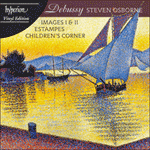 Debussy: Images, Estampes & Children's Corner - Vinyl Edition
Debussy: Images, Estampes & Children's Corner - Vinyl Edition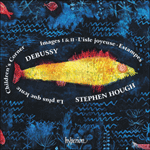 Debussy: Piano Music
Debussy: Piano Music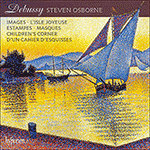 Debussy: Piano Music
Debussy: Piano Music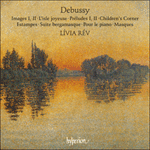 Debussy: Piano Music
Debussy: Piano Music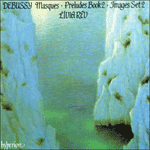 Debussy: Preludes Book 2
Debussy: Preludes Book 2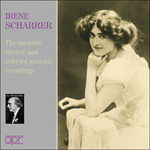 Irene Scharrer - The complete electric and selected acoustic recordings
Irene Scharrer - The complete electric and selected acoustic recordings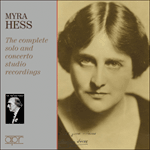 Myra Hess - The complete solo and concerto studio recordings
Myra Hess - The complete solo and concerto studio recordings
